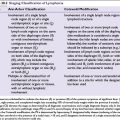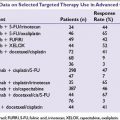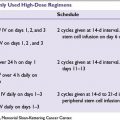Relapsed/Refractory SCLC
Relapsed SCLC is recurrent disease more than 3 months post completion of first-line therapy. Refractory disease refers to recurrent disease during first-line therapy, or within 3 months of treatment completion. Eighty percent of patients with SCLC and nearly all patients with ES SCLC will relapse after first-line therapy. The treatment of relapsed/refractory disease consists of palliative chemotherapy.
Common chemotherapeutic agents used are mentioned above, and are usually given as single agents, with an average response rate of 10% to 25%. The current recommended second-line therapy is single agent topotecan, which when compared to best supportive care in a registration randomized trial, was found to improve both quality of life and survival. Oral and intravenous topotecan shows similar response rates. Topotecan can be used in both the relapsed and refractory settings, with response rates of 11% to 31% and 2% to 7% respectively. A phase III trial comparing CAV (cyclophosphamide, doxorubicin, and vincristine) to topotecan in second line showed similar response rates (18% vs. 24%) and median survival (25 weeks vs. 24.7 weeks). Topotecan was associated with higher rates of thrombocytopenia and anemia, but had improved symptom control and less neutropenia compared to CAV. Risk factors for myelosuppression with topotecan include poorer PS, prior radiotherapy, extensive prior chemotherapy, prior platinum therapy, and renal impairment.
The median OS of relapsed, treated SCLC is 2 to 6 months. For patients with a longer disease-free interval and adequate PS, a rechallenge of initial chemotherapy regimen is reasonable. Response rates for irinotecan are similar to topotecan in patients with sensitive disease (30%) and refractory disease (<10%), with a median survival of 5 to 7 months. Single agent amrubicin has shown promising activity in refractory SCLC, with an overall response rate of 21.3%, median PFS of 3.2 months, and OS of 6 months, with an acceptable toxicity profile.
Surgery
SCLC presents rarely as an isolated lesion (<5% of cases). Patients with stage I SCLC (T1-2NO) can be treated with complete resection (lobectomy + mediastinal lymph node dissection), followed by adjuvant chemotherapy or chemoradiotherapy if mediastinal lymph node stage is negative or positive respectively. This approach yields a 43% to 53% 5-year survival rate. These recommendations are based on retrospective data and single institution studies. Two randomized trials in 1966 and 1994 investigated the role of surgery in SCLC, and did not support the role of surgery as the primary treatment of an isolated or recurrent lesion. These studies were done prior to the use of modern imaging techniques that would likely upstage many of these patients. A randomized trial of stage I SCLC to surgery versus combined chemoradiotherapy has not yet been done, but would be required to answer this clinical question. Adjuvant surgery after first-line chemotherapy (carboplatin/VP16 +/– ifosfamide) with or without radiotherapy was investigated prospectively in 23 patients with stage I to IIIA SCLC. In this study, only patients with a CR or pathologic stage I demonstrated a benefit in terms of local relapse and OS.
Prophylactic Cranial Irradiation
The incidence of brain metastases in SCLC at 2 years is 80%. Brain metastases represent an area of significant morbidity and mortality in SCLC. Prophylactic cranial irradiation (PCI) consists of 5 to 7 fractions of whole-brain radiotherapy delivered to prevent the onset of symptomatic brain metastases. Each treatment consists of 1.5 to 2.0 Gy per fraction. Higher doses (>3.0 Gy), concurrent chemotherapy, and high total radiotherapy doses have been associated with late neurologic toxicity. In LS SCLC, two meta-analyses demonstrated a 25% reduction in the cumulative incidence of brain metastases at 3 years (23% to 58%) and an improvement in 3-year OS with PCI (20.1% vs. 15.3%). In ES SCLC, the NEJM published an EORTC trial that showed those patients who exhibited either a partial or complete response to combination chemotherapy, benefitted from PCI. PCI reduced the incidence of symptomatic brain metastases from 40% to 15% at 1 year, and improved 1-year OS from 13% to 27%. PCI was well tolerated, with the commonest toxicities consisting of headache, nausea, and fatigue. PCI is not recommended for patients with a poor ECOG PS (3 to 4), multiple comorbidities, or impaired cognitive function. PCI is not given concurrently with chemoradiotherapy due to potentially cumulative neurotoxicity.
New Therapeutic Directions
Multiple strategies have been employed to try and improve response rates and survival in SCLC. These include additional agents, dose escalation, dose dense therapies, targeted therapies, and prognostic/predictive biomarkers.
Additional Agents
First Line A recent phase III trial of carboplatin/pemetrexed versus standard EP in first-line ES SCLC demonstrated inferior PFS and OS in the experimental arm. The addition of bevacizumab to standard EP improves PFS but demonstrated no OS benefit. Two phase III trials demonstrated a lack of benefit with the addition of paclitaxel to EP in ES SCLC, with an increase in treatment-related mortality in the experimental arm (6.5% vs. 2.4%). The addition of cyclophosphamide and epirubicin to EP showed an improvement in response rate and a minor improvement in survival, with a significant increase in hematologic toxicity. Ipilumumab, a CTLA4 inhibitor licensed in the treatment of metastatic malignant melanoma, was investigated in a three arm phase II study in first-line ES SCLC. Ipilumumab was administered either in a phased or concurrent basis with carboplatin/paclitaxel, and assessed by PFS, irPFS (immune-related), BORR (best overall response rate), irBORR, survival, and safety. Phased ipilumumab showed an improvement in irPFS, irBORR, and OS. Further studies with this drug are awaited.
Second Line Combination therapy with paclitaxel and carboplatin, doxorubicin, gemcitabine, cisplatin, and ifosfamide has yielded response rates of 25% to 75.3% in the phase II setting. Carboplatin and paclitaxel showed a response rate of 73% and would require further study. Five phase II trials investigated the combination of gemcitabine and irinotecan in the relapsed setting, with response rates ranging from 10% to 50%, and different conclusions reached in terms of therapeutic benefit. Combinations of gemcitabine with vinorelbine or irinotecan did not show any clinical benefit. Ifosfamide has been shown to improve OS and response rate in one trial, but this was not observed in subsequent validation studies. Picoplatin is a cisplatin analog that has shown preclinical activity in phase II studies in platinum-resistant and platinum-sensitive SCLC. It aims to overcome platinum resistance and in the phase II setting for relapsed/refractory disease demonstrated a 15% response rate and 30% disease control rate. The results of a registration trial are awaited.
Maintenance Therapy
Stay updated, free articles. Join our Telegram channel

Full access? Get Clinical Tree






